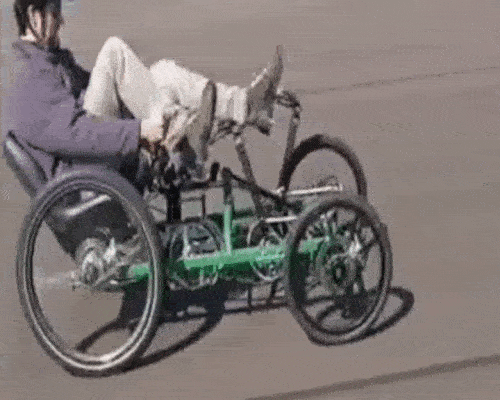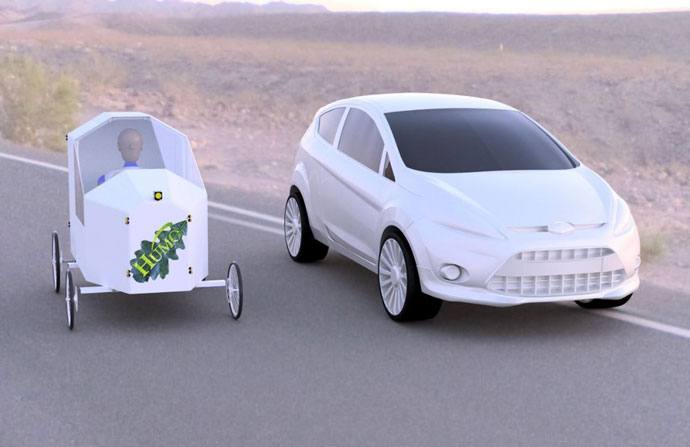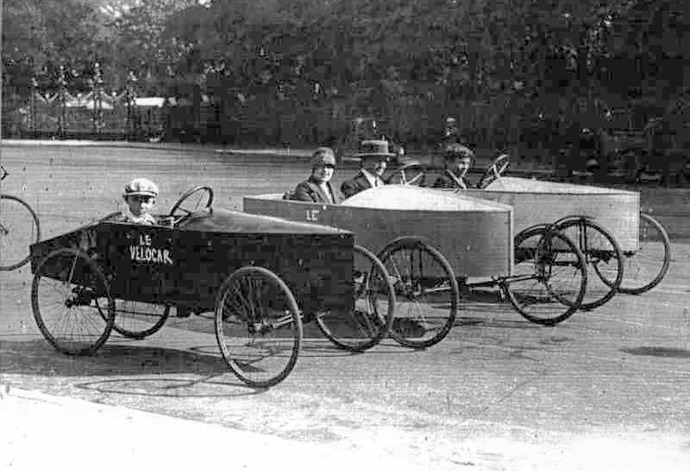
The idea of travelling in an extremely small and lightweight vehicle that will not move without physical effort from its driver will seem outlandish to motorists who do little more than turn a key, but we are great fans of human powered vehicles (HPVs). These environmentally benign vehicles could have a transformative effect on the way we get about town and cities by putting an end to road danger, noise pollution and the obesity epidemic.
The HUMO – seen above in its prototype form without bodywork- is an open source project taking a novel approach to the HPV. Inspired by the industrial application of ratchets, inventor Sebastian Cruft aims to build a human powered vehicle with an unassisted cruising speed on 25 mph. On a HUMO, the cranks rock through the vertical position. With a choice of axle positions you can end up with cranks that are up to three times the length of a normal bike crank.

The arrangement trebles the torque for the same amount of human power. At present the penalty for the clever engineering is weight – the current prototype has a steel construction and weighs 80 kg. However, the team expects an aluminium version to tip the scales at only 20 kg. Further details at humocars.com

The idea of human-powered cars is not new. Pedal-powered vehicles proved a popular way of getting about towns and cities in France during the 1930s and 40s. So efficient were these lightweight machines, that they broke cycling speed records. As a result, they were declared ineligible to race by cycling’s governing body.
It is estimated the Humo prototype will soon run at 25mph/40kph on a flat road, using only human power.
Your views about HPV travel
Please use the comments section at the bottom of this page to rank the following benefits of the Humo HPV with: number 1 being most important, number 6 least important. If you can think of another benefit that isn’t listed, please mention that in your comment – and where you would rank it.
- Environmental (no carbon-emissions, no pollution, negligible wear on roads, low vibration and noise levels, little environmental burden from manufacture)
- Performance (easy cruising speeds 20+ mph (30+ kph) under human power only, swivelling headlight means that when you’re travelling in the dark, you can actually see where you’re heading, electric assistance helps on steep hills and in headwinds)
- Economical (Saves money – no need to buy fuel or electricity [you can recharge the battery by pedalling when stationary], maintenance costs very low, low road and infrastructure costs)
- Practical (Four-wheel stability, all-over weather-protection, can be folded and stored safely indoor, good visibility, and easily seen by other drivers, can carry light loads – eg laptop, toolbox, sandwich-box, causes far less damage on impact than any motor-vehicle, no need to dismount and get your feet wet in rain)
- International (available for local manufacture – can be adapted to conditions in Iceland or Ethiopia, driver’s health benefits from exercise)
ETA: Ethical breakdown cover
Established over 25 years ago, and with over 5,000 recovery trucks on call 24/7, the ETA has a proven track record of providing efficient, reliable breakdown cover. We handpick only the best local mechanics and garages around Britain to send out if you break down. We believe this way of working is efficient, environmentally friendly and helps support local communities and economies, too. It’s one of the reasons we have been voted to be ethical by the Good Shopping Guide.
Winifred Ann Davies
I love the concept of hpv’s. I have two semi recumbent trikes and a traditional upright pedal assist trike which is great for doing the weekly shop and for getting up those hills on longer rides. It is especially useful around Christmas time when cars are circling round supermarket car parks like vultures waiting to dive into the first newly vacated parking space and having to face the other disgruntled drivers who thought the prize was theirs.
Ann (aged78).
John Holiday
They are also good fun!
Have a Burrows ‘Windcheater ‘ which I enjoy riding & always creates interest.
OAP Mike
The benefits of the Humo HPV in order of importance are, in my opinion, 1,3,4,2,5 with a 6 being to achieve low production costs utilising recycled materials where possible.
It would also be necessary to extend and create more cycleways as I fear HPVs would be extremely vulnerable on most conventional highways due to their low profile and relatively low speed; otherwise a great idea, especially in getting a fitter population.
Tony Williams
I think I’d put the environmental benefits top of the list, but in second pace I’d have a point you mentioned in the text but not in the list: the health advantages of the exercise the driver would get.
I can see that 25-30 mph is an advantage, but not entirely so, since in an impact a pedestrian could be quite seriously injured, and so could the driver. Adding the sort of safety features to remove sharp edges and to protect the driver will add weight. Of course there will be accidents – there were when all vehicles were horse-drawn. I note that you say the picture is of a prototype without bodywork. If the thing is foldable how sturdy will the bodywork be?
It could certainly be useful in heavily urban areas where traffic speeds are only moderate, if the final design offers the driver shelter from wet weather.
Alastair Seagroatt
Or there’s been a world record one for sale not too lon ago http://www.cyclingweekly.com/news/latest-news/graeme-obrees-beastie-bike-among-many-memorabilia-auction-351518
David
I would say 1,3,4,2. Health benefits to the drivers I would also put as important. 5 is aspirationsal. If used for commuting, you don’t need 25mph, 15mph is plenty, and it makes electrical assistance legal in more places. If this looks like a Human Powered Car, protects the driver from the elements, and allows them to get to work without getting sweaty you are on to a winner.
I don’t understand why anyone would use anything other than a bike for journeys between 3 and 10km, but people are put off by safety scare stories, poor facilities and getting wet and/or hot and sweaty.
eddie white
13425, I would agree with a lot of the points already made. Also the one shown could do with a few improvements ( rider looks very cramped up) an other materials, low cost but lighter could be used. It is a first rate idea though
Caroline Pearce
1, 4, 2, 3, 5
I would put health benefits in a separate category, rather than classify it as ‘international’ and then my ranking would be 1, 4, health, 2, 3, 5.
Mike Croker
1,4,3,2,5 and agree with the health benefit to the user comment made above.
‘Practicality’ is a tricky one, though, as the vehicle’s footprint and maneuverability deteriorate in comparison with a bicycle to the extent that I sometimes end up using motorcycle parking bays in my WAW velomobile, whereas yer humble 2-wheeler with a prop stand can fit in many urban crevices.
Rex North
I wonder if the creators of innovative ideas ever consider the needs of older people ? I have to say that, whilst this may be good for the environment it looks extremely uncomfortable and exposed to our very variable UK weather (as of course are cycles). The provision of a robust cover will, of course, add weight and make propulsion use more effort still
May be great for fit 20 year-olds, but not too much help in your 70’s ??
Chris Johnson
More than two wheels may be a problem for some on our (UK) steeply-cambered roads. Keeping one’s upper body upright (for stability) may cause significant back discomfort?
Paul Elmer
1,3,5,2,4
I love the idea, and the effeciency, especially of a reduced-weight version, but in the real world UK with its narrow congested lanes and generally poor cycle lane provision, a comparatively low, wide and slow vehicle like this would be a bit of a liability? And that is before you tried to get it uphill laden with shopping, getting the nearside wheels stuck in every drain grid and pothole. Cool though, in a Sinclair C5-ish way, and in trendy city centres I could see it taking off. I never imagined commuters would pay £3k for a fancypants commuter bicycle, but they do. This could come in at £4k – 5k, and probably would? In the UK, you’d really need a nice car free path from your waterfront flat to the office, which limits your customer base a bit. And fairtrade cappucino holders, moulded from bamboo, natch. Titanium bits and bobs, carbon fibre whatnots, you know where I am heading. That’s what I think the UK market would make of it.
Put it somewhere flatter and with better cycle paths (Netherlands, Germany?) and the balance shifts to useability. Also, make it a tandem/triple or give it a capacity to take a stoker/passenger and the practical appeal is transformed. Unlike the poster above, I could see that with modification it might offer a route for mobility for the fitter over 50s – and for younger families, a bit like a Nihola family bike or a Circe tandem/triple. And, like the Nihola and the Circe, probably too expensive for broad appeal.
Internationally, I am unsure if it is really a low-cost vehicle for parts of asia. If a passenger could be taken it might work especially in areas where transporting the ageing population to healthcare providers is a growing problem, but I can’t help thinking that putting the nurse on a moped to granny’s village is even better. But in urban development there is a massive opportunity, there is a huge area in northern China, west of Beijing, where green technologies are earmarked to be the foundation of several linked new cities – if they don’t build decent cycle routes in those new cities, and integrated public transport hubs, I’ll eat my hat. That’s where I’d place it, as a tool for the urban environmentalist, and as a genuine transport solution.
I love the benefits of being enclosed from the weather (what cyclist wouldn’t?) but in my heart I wonder if is this really a more practical solution than a bicycle and trailer, cargo bike, etc?